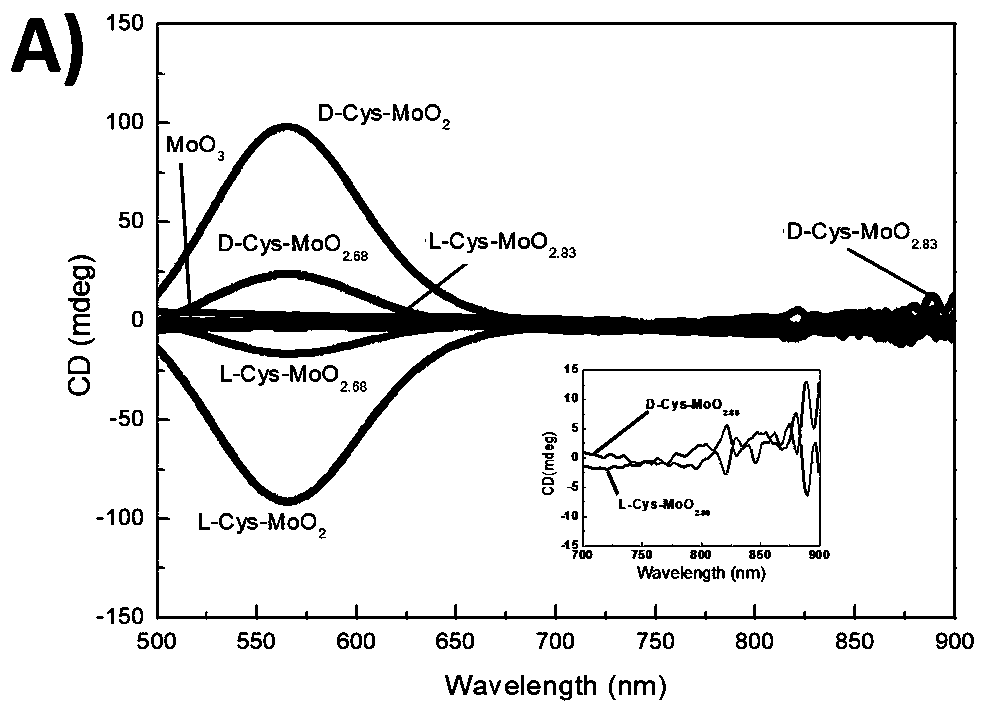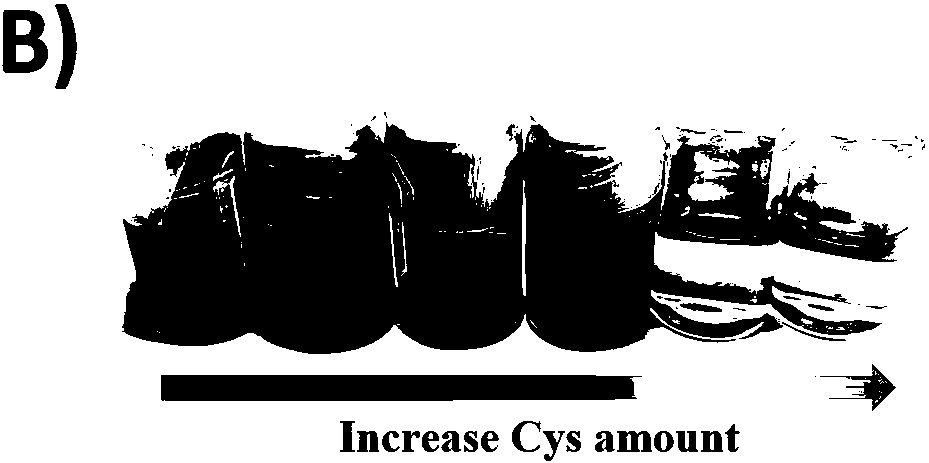Preparation method of chiral light-controlled oxygen-deletion molybdenum oxide nanometer particles and purpose of chiral light-controlled oxygen-deletion molybdenum oxide nanometer particles to photothermal therapy of tumors
A technology of oxygen deficiency and molybdenum oxide, which is applied in molybdenum oxide/molybdenum hydroxide, nanotechnology for materials and surface science, anti-tumor drugs, etc., can solve the problem of lack of selectivity, and achieve simple preparation and operation. Restoration effect
- Summary
- Abstract
- Description
- Claims
- Application Information
AI Technical Summary
Problems solved by technology
Method used
Image
Examples
Embodiment 1
[0045] Dissolve 80 mg of molybdenum disulfide black powder in 46.25 mL of deionized water. With continuous stirring, 3.75 milliliters of mass fraction of 30% hydrogen peroxide was added to the solution. Afterwards, the stirring was continued until the black solution turned yellow, and then the solution was heated to 80°C to slowly remove excess hydrogen peroxide. Stop heating after the solution turns from yellow to colorless, and the total heating time is about 1 hour. The product is molybdenum trioxide mother liquor. Chiral MoO 3-x Nanoparticles are achieved by stepwise reduction of molybdenum trioxide mother liquor. Specifically, taking about 1.5 ml of mother liquor, adding about 5 mg of cysteine can be reduced to L- / D-Cys-MoO 2.83 (blue); adding about 20 mg of cysteine will reduce to L- / D-Cys-MoO 2.68 (green); adding about 60 mg of cysteine will reduce to L- / D-Cys-MoO 2 (brown). Thereafter, the absorption spectrum of the chiral sample was measured by a TU-1901 ...
Embodiment 2
[0047] The heating curve of the surface cysteine-modified Cys-MoO3-x nanoparticles (20D / L, 60D / L, 80D / L) was measured by Script Communicator software, which is a scriptable cross-platform data terminal. Add MoO3-x nanoparticles into 24-well plate, 500 μL / well. Then irradiate with 808nm (D / L) near-infrared light to 20D / L and 60D / L, and irradiate with 532nm (D / L) visible light to 80D / L, 15 minutes per well. The data is received by a temperature probe, one end of which is connected to the computer, and the other end is inserted into the corresponding MoO3-x solution. Determine the final heating capacity curve of MoO2 nanoparticles (20D / L, 60D / L, 80D / L) by taking the average value of three repeated experiments.
[0048] Currently obtained 6 kinds of L- / D-Cys-MoO 3-x Nanoparticles have good light heating and heat production efficiency. The chiral MoO is evaluated by measuring under 808nm near-infrared light and 532nm visible light. In the experiment, the laser power density is 1....
Embodiment 3
[0051] As the culture time increases and the cells continue to divide, on the one hand the cells come into contact with each other causing the growth rate to slow down or even stop. On the other hand, it is not conducive to cell growth due to nutrient deficiency and accumulation of metabolites. Passaging to allow cells to grow normally. Take out the culture bottle from the incubator, add 1ml PBS to wash the serum, after washing, add 1ml trypsin to digest the adherent cells. Then, place the cells in the incubator for 7-8 minutes, remove the culture bottle and add 1ml medium to neutralize the digestion by trypsin. Transfer the cells in the culture flask to a centrifuge tube and centrifuge at 800 rpm for 5 minutes. After centrifugation, discard the supernatant, add 1ml medium and blow evenly (to prevent cell aggregation). Then take three culture flasks, add 4ml medium and 40μl double antibody (penicillin and streptomycin) respectively. 1 ml of the cell solution was pipetted, ...
PUM
 Login to View More
Login to View More Abstract
Description
Claims
Application Information
 Login to View More
Login to View More - R&D
- Intellectual Property
- Life Sciences
- Materials
- Tech Scout
- Unparalleled Data Quality
- Higher Quality Content
- 60% Fewer Hallucinations
Browse by: Latest US Patents, China's latest patents, Technical Efficacy Thesaurus, Application Domain, Technology Topic, Popular Technical Reports.
© 2025 PatSnap. All rights reserved.Legal|Privacy policy|Modern Slavery Act Transparency Statement|Sitemap|About US| Contact US: help@patsnap.com



